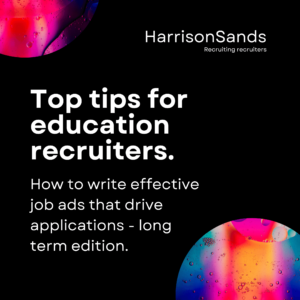As a recruiter, you’ll no doubt develop your own style and process for running interviews with candidates. But how effective is this at getting the information you really need? And the flip side of course, is thinking about how well you fare when sat on the other side of the table and you’re being interviewed for your next recruiter role? Well the Harrison Sands team are here to help by exploring the well-regarded STAR technique and explaining how to get the best out of it.
The STAR technique, for those that don’t already know is an interview technique that’s typically used to steer a conversation along a particular structure and in the process, ensure that information about a candidates’ specific capabilities – relevant to the job they’re interviewing for – are uncovered. In brief, the mnemonic STAR stands for: Situation, Task, Action and Results – and we’ll explain more about each one below.
Situation – Just as you would do when talking to someone and trying to explain something, it’s a good idea to first set the scene and describe the situation you’re about to explore further. So, give some context and background to the situation so the interviewer can understand what you’re about to tell them.
Task – This is the particular task you were presented with in the scenario you’re explaining. It’s important at this stage to focus on the task you specifically faced or tackled, rather than talking more generally about the rest of the team and what they did. Also consider explaining the importance of the task itself, and where appropriate the impact of not completing the task.
Action – Arguably the most important aspect of the STAR technique, this is your chance to shine and explain to the interviewer what it was you specifically did. You must use this part of your answer to demonstrate what you did as a person, rather than as part of a team – so it’s clear it’s your competency you’re demonstrating to the interviewer. Use plenty of detail and remember the interviewer may not be familiar with your history, background or know the company you’ve worked for in the past. Be sure to contextualise your answers and relate them back to the question being asked.
Result – In the majority of circumstances, you’d want to demonstrate a positive outcome and show where you’ve made a difference. If you can quantify the impact you’ve had, do so. In the recruitment world metrics, particularly financial ones, will go a long way towards demonstrating capability – so don’t be shy about sharing the details of your successes.
Which questions need a STAR response?
The STAR technique can be an invaluable tool in any recruiter’s arsenal, but perhaps most importantly by adopting this approach it allows hiring managers to compare applicants in a more structured manner.
To finish, it’s worth sharing our top tips for answering STAR questions.
- Be specific when answering a STAR question, try to avoid being vague and don’t just talk in generalities. Quantify numbers and improvements. For example, don’t just say that your perm fees improved year on year, explain the percentage or monetary value that they increased.
- Address the question. Equally appropriate with non-STAR interview questions, it’s particularly important here that when asked to demonstrate a specific competency that you ensure you answer the question being asked. Try to avoid selecting a scenario from your past and forcing a link to the question.
- Think about the timing. It’s important to find the right balance in the time you take to answer STAR questions. Try not to let your answers drag on or venture off on a tangent from the competency or skill you’re being asked about. And try and avoid rushing through your answers too quickly too.
- Make it free flowing. Although we’re advocating the technique to help structure your answers, it’s best to try and avoid making it overly obvious that you’re breaking your answers down into these separate sections. Doing so can make the conversation feel unnatural and can distract the hiring manager. So just be relaxed and natural, don’t rehearse answers too much and let the conversation flow.
For more help or advice about interviews, or to find out more about Harrison Sands can help you with your next career move, contact us today.


